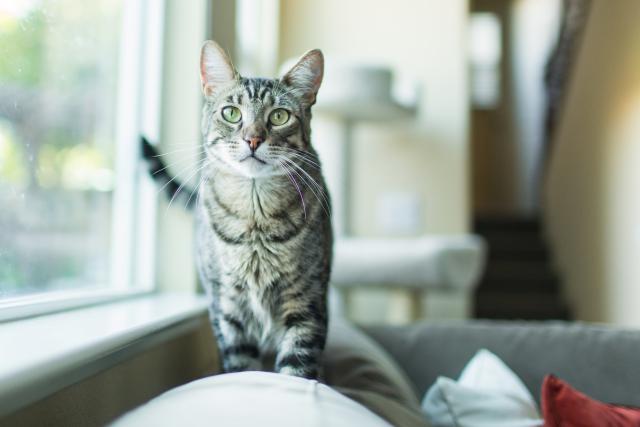Do you sometimes have trouble understanding your cat? All cats being different, the task may be complicated! It is commonly accepted that these animals are distant and independent creatures who prefer not to receive too much attention from their human masters. However, all cats do not necessarily correspond to this stereotype. Many of them are affectionate and sociable creatures who enjoy the company of both humans and other cats. Whatever your cat’s personality, you will not waste your time trying to better understand his behavior, as this will allow you to communicate better with him.

Method:1
Understanding the Meow of Your Cat:
1. Why does a cat meow? We are all used to hearing cats meow. This multi functional means of communication can mean many things, but its main purpose is to communicate to us a particular need: “Concentrate on me because I want you to give me something”. It is possible that your cat is hungry, that he is looking for your attention or your caresses or that he wants to make you understand that he does not want you to touch him. A master learns very quickly to interpret the different meow of his cat and ends up knowing exactly what he has in his head.
o After spending some time with your cat, you will be able to interpret its meowing according to various variables such as the time of day or where it is when it mews.
2.Why does a cat purr? It is very common to hear a cat expressing itself by purring. Although all cats do not purr when they’re happy, it’s a good sign if yours starts purring while you’re caressing him. Do not be discouraged if your cat never expresses it that way. It is possible that this means of expression is not part of his vocabulary.
o It is true that a happy cat purrs, but this animal can also purr when it is in distress. In this case, it would seem that the purr is a kind of “call” for help.
3. Why does a cat spit and scold? This kind of behavior means that your cat is afraid or that he is angry. Never try to catch a cat whistling, spitting or scolding, as it may be aggressive and bite you. If possible, leave the cat alone. If you absolutely have to pick it up, be careful and get close to it with a thick towel and leather gloves.
Method: 2
Understanding the body language of her cat:
1. Learn to identify anger or fear in your cat by observing his or her body language. A cat does not necessarily spit or scold when he is afraid or angry. An angry cat will have the pupils dilated and will look in the direction of what made him angry. Its coat will normally be bristling and it will sometimes quickly swing its tail while keeping it in an inverted U shape.
o In addition, a frightened or angry cat may return his ears back to a flattened position.
o On the other hand, a friendly cat will approach you with the tail in the air and the ears straight. He will come and rub against your legs. He will also be able to address you one or more friendly meowing and even purr.
2. Why do cats rub themselves with humans? Cats are affectionate and reactive creatures. They will sit next to you and rub your legs while meowing to attract your attention. This behavior is quite normal. This allows them to leave their smell on the recipient and create links with it. It is very likely that this behavior has other meanings, but we are not certain.
o The fact of rubbing against a human being is very important for the cat. It is a ritual that allows it to create emotional ties. If it comes to rub you, do not chase it. Let him show you his affection and give you attention.
o The cats that rub each other make of the grubbing.
3. Why does your cat “knead” you? This behavior surprises many masters. Some cats “knead” their owner. It is a vestige of their childhood. The kittens knead their mother’s mammary glands to make the milk flow. It seems that this behavior reassures the cat when it reproduces it on a human that it loves.
o The cat can become aggressive during kneading especially if it uses its claws. It is important that you protect yourself if you know your cat is going a little too far when kneading. Try to wear a long-sleeved shirt or protective clothing to avoid injury. You can also prevent your pet from continuing when it begins to hurt you.
Method: 3
Understand the behavior of cats:
1. Understand the feline hierarchy. When cats live together, a hierarchy naturally takes place. One cat will dominate the other. The owner may not be aware of this situation and will wonder why his cats are arguing over the litter box or other things at first. But by carefully observing your animals, you will realize that the dominant cat stiffens his gait when he goes to his companion. His ears will be straight and the base of his tail will be elevated. On the other hand, the dominated cat will turn away its eyes, lower its ears and frequently avoid crossing the road of the dominant cat.
o The hierarchy that takes place between cats is natural. Just make sure that all your cats are happy and healthy, regardless of their hierarchical rank.
2. How does a cat respond to the arrival of another cat in the home? Your cat will probably take time to accept the arrival of a kitten or other adult cat at home. He will see the newcomer as a threat and will certainly receive him with a lot of whistling, spitting and rumbling to make him flee. This behavior is perfectly normal. Introduce them with caution repeatedly. After some time, they will get used to each other and maybe become good friends [4]
3. Why is it important to know that cats create links between them? Although cats are cataloged with solitary animals, they create emotional bonds between them. When two cats become friends and one of them dies, his companion can fall into depression for several months. A depressed cat can constantly manipulate and stop feeding. In this case, it is important that you give a lot of love to your cat and that you console him.
Method: 4
Understanding the destructive behavior of her cat:
1. How do cats show their sadness or discontent? They do it in several ways. These animals are sensitive creatures that experience loneliness, boredom, fear or stress. A stressed cat will express it in different ways: meowing or forgetting her daily toilet ritual. Take time to observe your cat and her habits to spot her normal behaviors and detect any changes in her routine. This will allow you to better understand it.
2. Make sure your cat’s litter does not cause it to urinate anywhere. Most people who have cats know that the litter box plays a very important role in family life. It promotes the comfort of all occupants of the house including the cat. When a cat stops using it to urinate, this can cause serious problems and may even be expelled from his home.
o Why does a cat refuse to use his litter box? For many reasons. The answer is sometimes simple. For example, the cat does not like the texture or odor of its litter. Most cats prefer a non-perfumed litter. Or, an older cat can not enter the ferry because of his arthritis. The tray may be too dirty and needs to be emptied and cleaned more regularly (with soap and water). A sudden noise like the barking of a dog or the sound of another animal could scare your cat while he was in his ferry.
o If the household has several cats, it is possible that the dominant cat will prevent the dominated cat from using the bin. In this case it is best to add an extra litter box to the total number of cats you own. For example, if you have two cats, buy three bins and scatter them to different places in the house so that the dominant cat can not keep them all at the same time.
3. For what other reasons does a cat not urinate where it should? For example, if the patient is urinating on the bed or chair of a master or on plastic bags, a cat may suffer a urinary tract infection or other serious illness. Such behavior may also indicate that the cat experienced anxiety as a result of his master’s prolonged absence. If your cat suddenly starts to urinate outside the tank, consult your veterinarian to rule out any possibility of illness.
4. Why do cats scratch home furniture? Because they like it. Moreover, it allows them to manicure their claws. It is impossible to prevent a cat from clawing, as this gesture is very important to him. The best way to prevent a cat from clawing on your favorite chair or sofa is to divert your attention to something else.
o Offer a cat tree to your pet and encourage it to use it by scenting it with catnip and adding toys. If your cat does not like his tree, it’s possible that his texture will put him off. Replace it with another type of fabric and see if your cat prefers this one.
Advice
• It is by being attentive that you will come to understand the behavior of your cat.
• NEVER strike a cat that behaves badly (or even very badly).
• The more calm and relaxed your cat will be.
Warnings
• Never take in your arms a cat that growls, whistles or spits.
• If your cat is hiding or fleeing when you approach it, it is best to leave it alone because it could hurt you.
• You will have to consult many times a veterinarian or an animal behavior professional to correct the behavior of your cat.
